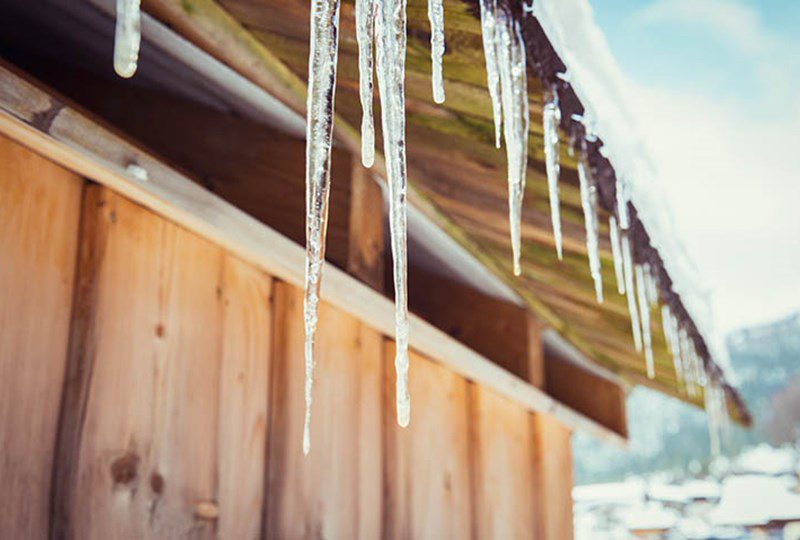As the coldest months of the year approach, homeowners in Minnesota and western Wisconsin are wondering how to prevent hazardous ice dams — and how to get rid of them once they appear. Here are insights you can use to keep your home safe from ice dams and the damage they cause.
What are ice dams? When do they occur?
Ice dams commonly occur after a weather pattern that is all-too-common to Midwesterners: A generous dumping of snow, followed by a warmer “heat wave” that causes that snow to melt rapidly.
When the snow melts high up on a roof, it begins draining down. But if the gutters or eaves begin to back up — either from ice that has yet to melt, leaves that weren’t removed before the snowfall or simply a large volume of water coming all at once — the water may freeze into larger, continuous chunks of ice called ice dams.
From there, the damage quickly sets in. Water may drip past the dam, creating long icicles that can reach several feet in length before they break. While those can be a hazard, it’s what happens behind the ice dam that’s far more treacherous.
When water backs up behind the dam, it can leak back into your home, damaging the shingles and roof and eventually seeping into the walls, ceiling and insulation. Often, this damage can go unnoticed, especially if it’s hidden in an attic that isn’t accessed in the cold winter months.
Why do I have ice dams even when the temperatures aren’t warm enough to melt the snow on my roof?
Sometimes, homeowners may notice ice dams forming even if the weather has been consistently cold. In that case, it’s important to consider that your home may have gaps in the insulation, which are allowing warm air to seep out. That draft acts the same as a warm weather pattern would — it heats up the snow to melt, but the snow rapidly freezes and causes buildup once it drains down.
Edina Realty agent Ross Kaplan captured what this might look like on his blog: Says Kaplan, “To an untrained eye, there are simply two spots on the roof that are snow-free. To someone who knows about ice dams, though, there are two ‘hot spots’ on the roof.”
Whether it’s missing insulation or heat escaping from a bathroom just below, the result is that heat is escaping to the roof, which Kaplan says is “causing snow to melt and (possibly) accumulate and re-freeze above the gutter.”
Remember when your dad or grandpa would tell you to close the front door because you’re “heating the whole neighborhood?” When you have a gap in your insulation, you’re essentially doing just that — plus you’re causing yourself the added pain of time and money to fix the ice dams once they’ve accumulated.
So, what can you do to prevent ice dams or fix them once they’re formed?
How can I prevent ice dams this winter?
The best way to prevent an ice dam is to keep your roof cold so that the snow doesn’t melt and create damaging buildup. Be sure to check your attic or upstairs for gaps and leaks in insulation, and to air seal the attic if you haven’t already.
A cheap (though time-consuming) option for one-story homeowners is to run an aluminum roof rake over the top of your roof after heavy snowfalls. These roof rakes come on a telescoping pole and are sold at home improvement stores — but they go fast during the winter months, so stock up early.
What can I do to fix ice dams and their damage if they do form on my roof?
Unfortunately, the prevention strategies listed above aren’t foolproof or comprehensive— remember, it may be an unexpected warm weather blast that causes your ice dams to form and water to leak back into the house. And there’s nothing you can do to keep Mother Nature in line.
If an ice dam forms, it’s best to call a professional. Last year’s weather patterns created an abundance of ice dams and local news station WCCO aired this segment detailing how specialists remove and prevent future ice dams even in the middle of the winter by:
- Heating the roof with 300-degree steam that causes all the snow and ice dam to melt away.
- Laying down commercial-grade heat tape to prevent ice dams from building up again.
- Inspecting top-floor and attic areas for insulation and ventilation problems and making recommended fixes.
Key takeaways on ice dam prevention and removal
Homeowners should be on the lookout for three key indicators of ice dams this winter:
- Warm weather after a heavy snowfall.
- “Hot spots” — or areas where snow has melted — that are visible on the roof.
- The accumulation of icicles, which can be an early indicator of an ice dam that may soon cause interior home damage.
When in doubt, call a professional who can help inspect your roof and attic for damage and recommend potential short- and long-term fixes.
Article courtesy of Edina Realty

